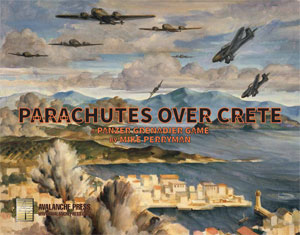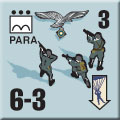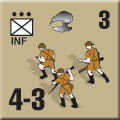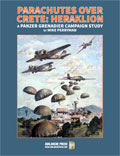Parachutes over Crete:
Scenario Preview, Part One
by Mike Bennighof, Ph.D.
February 2024
 Parachutes Over Crete is that most unusual of Panzer Grenadier games: Panzer Grenadier without panzers. What is has instead is elite infantry: German paratroopers, German mountain troops, New Zealand and Australian infantry, and Maoris. Plus gun-loving Cretans. Parachutes Over Crete is that most unusual of Panzer Grenadier games: Panzer Grenadier without panzers. What is has instead is elite infantry: German paratroopers, German mountain troops, New Zealand and Australian infantry, and Maoris. Plus gun-loving Cretans.
Mike Perryman’s scenarios cover all of the key fighting from the May 1941 German air assault on Crete, a large, strategically-important island south of Greece. The fighting took place in the areas around the island’s airfields, from whence the Germans could then spread out to occupy the rest of Crete. Both sides knew that possession of these objectives would be all that really mattered.
The first chapter covers the assault of the German 1st Air Assault Regiment on the airfield at Maleme, defended by a reinforced New Zealand brigade. Let’s have a look at the nine scenarios:
Scenario One
Maleme: Hill 107
20 May 1941
The 1st Air-Landing Assault Regiment’s primary objective was the airfield just outside of Maleme, and Col. Eugen Meindl focused his brigade-sized formation’s attention there. Hill 107 overlooked the airfield and were it not quickly secured, the airfield’s New Zealand defenders could use it to keep the airfield under fire and prevent he landing of reinforcements and supplies. Despite its tactical importance, only a small force protected the hill.
Conclusion
Meindl and his staff had enough gliders to land two companies; the rest of the regiment would land by parachute. Glider troops had a much better chance of attacking their objectives quickly, as they did not have to find their weapons first, and Meindl assigned them the most important tasks. He detailed one of the companies to attack the anti-aircraft batteries at the mouth of the Tavrontis River, and the other to take Hill 107. The strength of the New Zealand defense on Hill 107 surprised the Germans, and they could not push the Kiwis off the height.
Notes
We start the game with a pair of intro scenarios to let you try out the game system with a couple of actual battles. It’s a small battle, with the Germans trying to kick the New Zealanders off a very high hill (by Panzer Grenadier standards). The Kiwis don’t want to leave.
Scenario Two
Maleme: By the Tavronitis
20 May 1941
 While I Battalion commander Maj. Walter Koch led 4th Company’s attack against the New Zealanders on Hill 107, Oberleutnant Wulf Baron von Plessen’s 3rd Company would eliminate the anti-aircraft gun positions at the mouth of the Tavrontis River. The New Zealand battalion and brigade staffs believed the guns poorly positioned against enemy glider landings and received permission to move them at 0300 on 20 May. Before they could be shifted, the Germans arrived. While I Battalion commander Maj. Walter Koch led 4th Company’s attack against the New Zealanders on Hill 107, Oberleutnant Wulf Baron von Plessen’s 3rd Company would eliminate the anti-aircraft gun positions at the mouth of the Tavrontis River. The New Zealand battalion and brigade staffs believed the guns poorly positioned against enemy glider landings and received permission to move them at 0300 on 20 May. Before they could be shifted, the Germans arrived.
Conclusion
The German glider troops overran the anti-aircraft guns, completing their primary mission. Plessen re-formed his men for an effort to capture the airfield and link up with Koch and 4th Company, but was killed leading from the front and the attack faltered. The Germans would have to wait for their parachute-landed comrades to join them.
Notes
This one’s a little bit larger, with the Germans (glider-landed, so they have all of their weapons) out to knock off a British anti-aircraft battery. It’s a tough assignment, since the anti-aircraft guns can shoot back with telling effect.
Scenario Three
Maleme: The Assault Regiment's Assault
20 May 1941
Shortly after 0600, German planes subjected Maleme’s defenders to a heavy and prolonged air strike. The Germans had made a habit of such breakfast air strikes, but not of such length and intensity. Shortly before 0800 the German aircraft began to break off the attack and the Kiwi sentries spotted transport planes and some gliders heading their way.
Conclusion
A widely-scattered drop contributed enough casualties to render the Assault Regiment’s 3rd Battalion combat-ineffective in less than an hour. This derailed the eastern prong of the German attack on the airfield before it had even started. The defenders concentrated on the parachutists trying to reach the airfield from the west, resulting in little German progress. The only promising development was capture of the bridge over the Travronitis River allowing reinforcements to join the attack.
Notes
This is a larger scenario encompassing both of the first two and starting earlier so the Germans have to arrive by parachute drop (and glider landing) and make use of the special landing rules. Much of the German player’s success or failure will ride on those landings, and how aggressively the German tries to push the landings zones close to his or her objectives.
Scenario Four
Maleme: A Pitiful Response
20 May 1941
By 1700 the 5th New Zealand Infantry Brigade appeared to have the situation around Maleme well in hand. Two of the brigade’s battalions remained relatively unengaged and were sending out small patrols to flush out the few German snipers in their areas. Around the airfield the third battalion (the 22nd) remained intact as a fighting formation and held its own. The only two Matilda tanks in the sector came forward to assist them.
Conclusion
The poorly-coordinated New Zealand attack went off without reinforcements other than the two Matilda tanks, which made little impression on the Germans. Confusion continued during the night, when 22nd Battalion pulled back and left both Hill 107 and Maleme airfield open for the Germans to occupy without a struggle.
Notes
The Kiwis (not many of them) counter attack supported by tanks (even fewer of them). Even worse, the tank crews might decide on their own to run away. This one’s going to be extremely tough for the New Zealanders.
Scenario Five
Maleme: Hostile Reception
20 May 1941
 German intelligence assessments predicted that the perpetually-restless Cretan civilian population would welcome the invaders as liberators, or at worst with indifference. Centuries of clan vendetta had produced a belligerent and well-armed society plagued by blood feud and murder. When a German parachute company landed just south of Kolimbari that Cretan rage found a new target. German intelligence assessments predicted that the perpetually-restless Cretan civilian population would welcome the invaders as liberators, or at worst with indifference. Centuries of clan vendetta had produced a belligerent and well-armed society plagued by blood feud and murder. When a German parachute company landed just south of Kolimbari that Cretan rage found a new target.
Conclusion
Taking a break from murdering one another, the Cretans assaulted the Germans with shotguns, pistols and farm tools. Unexpectedly hard fighting delayed the German advance to secure Koukouli Pass. Most sources fail to mention this small battle, and it’s possible that a German officer invented it to excuse the slow deployment to Koukouli.
Notes
It’s an ambush! An armed society is not a polite society. A lot of bad guys have a lot of guns and they’re ready to use them on their German guests. This tale of heroic gun-loving Cretans might be a fantasy.
Scenario Six
Maleme: The Second Day
21 May 1940
Despite the New Zealand withdrawal, it took the exhausted Germans some hours to occupy Hill 107 and the airfield. Reinforcements parachuted in and, with Meindl having been shot in the chest and gravely wounded, Assault Regiment second-in-command Bernhard Ramcke organized a fresh attack on the New Zealand brigade.
Conclusion
The Germans heralded their coming attack with a large-scale aerial bombardment, but still managed to surprise the Kiwis by moving against Pyrgos from the south. The New Zealanders turned them back, but only after heavy fighting. New Zealand reports credited the Cretan partisans fighting alongside them – reinforced by stragglers from 22nd Battalion – for offering particularly spirited resistance.
Notes
Ramcke counts his men, and finds enough to push the Kiwis off the airfield. Some of the Germans parachute in to reinforce the attack, again presenting the German player with a tough choice of how far forward to place those landing zones. The New Zealand player has a company of Maoris to stiffen the defense, and some gun-loving Cretans.
Scenario Seven
Maleme: A Sad Tale
22 May 1941
 Having secured Maleme airfield, the Germans began to land mountain troops brought in by airlift from Greece. Fifth Brigade commander James Hargest planned an attack with four battalions, assuming that one of them would be relieved by an Australian unit to become available for his attack – but Creforce headquarters had not actually promised that this could be done in time. Hargest’s attack finally moved out hours later than planned. Having secured Maleme airfield, the Germans began to land mountain troops brought in by airlift from Greece. Fifth Brigade commander James Hargest planned an attack with four battalions, assuming that one of them would be relieved by an Australian unit to become available for his attack – but Creforce headquarters had not actually promised that this could be done in time. Hargest’s attack finally moved out hours later than planned.
Conclusion
While some did better than others, none of the attacking battalions, even the fierce Maoris, reached their objectives. Intense German air attacks help drive off 20th Battalion, while 21st Battalion and the Maoris were stopped by German resistance on the ground. When both tanks were put out of action the attack lost its steam. Attacking under the cover of darkness as planned, when the German planes couldn’t make their presence felt, might have yielded a better result.
Notes
It’s a pretty weak counter-attack by the Kiwis, and once the sun comes up the airplanes arrive to make it even tougher. The tank support is weak, and there’s not a lot of artillery backing the New Zealanders, who are going to have to count on their undeniable fighting spirit.
Scenario Eight
Maleme: Mountain Men Attack
22 May 1941
Julius Ringel’s 5th Mountain Division had been flown to Crete to join the paratroopers in their attack, and that’s exactly what he intended to do. As soon as the New Zealand attack on Maleme airfield had been repelled, the mountain troops replaced the airborne units on the defensive perimeter. And as soon as they had secured their positions, they began to expand them.
Conclusion
The mountaineers pushed the New Zealanders back off all their morning gains, but the Kiwis managed to stop the Germans short of Xamoudhokhori. Creforce headquarters believed that the Germans would next attack from the south with the intention of pocketing 5th Infantry Brigade. With the airfield, lost the New Zealanders made plans to fall back during the night.
Notes
The mountain troops have a morale only slightly less awesome than that of the airborne, and they’re way better supplied with support weapons. New Zealand morale is still holding, but it’s going to be tough for them to maintain their positions.
Scenario Nine
Maleme: Bridge over the Platanias
23 May 1941
Following the failed counter-attack, Creforce pulled 5th Brigade back behind the Platanias River, with the withdrawal covered by the 28th “Maori” Infantry Battalion. The Germans pursued, and when the Kiwis had made it over the river the Maoris counter-attacked the Germans to keep the only bridge in the area out of their hands.
Conclusion
The Maoris had little artillery support, and little support from the rest of the brigade (just a few belligerent stragglers from the slow-moving 20th Infantry Battalion). The attack pressed to within a hundred yards of the vital bridge, but there German resistance stiffened and the paratroopers held onto the prize.
Notes
It’s a small scenario, with a parachute company well-supplied with support weapons holding a bridgehead against slightly less than two companies of Kiwis, but most of those Kiwis are Maoris of fanatic morale. This is a simple, and very tough, infantry fight between elite combatants.
And those are the Chapter One scenarios. Next time, we look at Chapter Two (half of it, anyway).
You can order Parachutes Over Crete right here.
Add More Fun!
 Parachutes Over Crete: Heraklion Parachutes Over Crete: Heraklion
A set of nine scenarios, plus historical background and three battle games, drawn from the May 1941 German airborne assault on Herkalion, capital of Crete, defended by the British 14th Brigade and determined Greeks. Requires Parachutes Over Crete and Road to Dunkirk.
You can order Heraklion right here.
Parachutes Package
Parachutes Over Crete
Road to Dunkirk
Heraklion
Retail Price: $192.97
Package Price: $155
Gold Club Price: $124
You can experience the Parachutes Package right here.
Sign up for our newsletter right here. Your info will never be sold or transferred; we'll just use it to update you on new games and new offers.
Mike Bennighof is president of Avalanche Press and holds a doctorate in history from Emory University. A Fulbright Scholar and NASA Journalist in Space finalist, he has published a great many books, games and articles on historical subjects; people are saying that some of them are actually good.
He lives in Birmingham, Alabama with his wife and three children. He misses his Iron Dog, Leopold. Leopold was not parachute-deployable.
Want to keep Daily Content free of third-party ads? You can send us some love (and cash) through this link right here.
|
